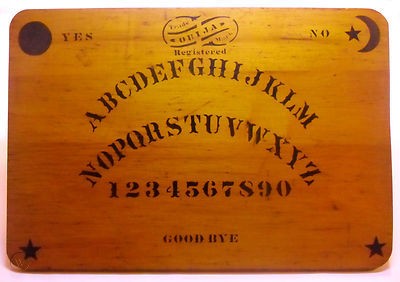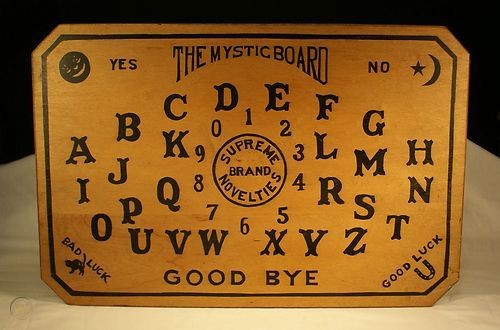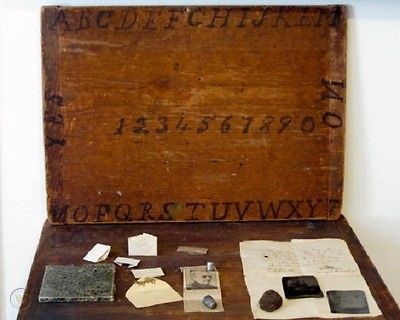
Before being manufactured under the name Ouija, these famous black-lettered boards were called talking boards. They were objects of the American spiritualist movement of the late 1800s. At that time, spiritualism was popular and fascinating to many. The focus of spiritualism was talking with the dead. As a result, seances, mediums, and messages from beyond the grave were part of the public lexicon.
Origins of the Talking Board
Early talking boards were handmade and first appeared in the late 1880s. Mediums believed they could use them to channel messages from the dead. Before talking boards, mediums used other techniques to channel these messages. For example, in the practice of table-tilting, an entire table is rotated or tilted to select different letters of the alphabet. Spelling out a long message could be taxing. For 19th-century spiritualists, the first wooden talking boards were time-saving devices.
An 1886 newspaper article described talking boards used in spiritualist camps in Ohio. Elijah Bond, a Baltimore lawyer, patented the Ouija board in 1891. He worked closely with his sister-in-law, Helen Peters, who was a medium.
According to Ouija historian Robert Murch, the board’s creators asked what they should name it. When they put their hands on the planchette, it spelled out “O-U-I-J-A.” Peters was wearing a locket with a similar word on it.
Baltimore businessman Charles Kennard saw talking boards, specifically the Ouija board, as an opportunity to capitalize on the spiritualist movement. He started the Kennard Novelty Company along with Bond and Colonel Washington Bowie. But in 1892, Kennard left the company and created a new one to produce a competing talking board, the Volo board. In 1897, he tried again with the Igili board. Over the years, there were other competitors, such as the Oriole in 1904.
Now talking boards had gone beyond their beginnings in spiritualism. Kennard marketed them as a wholesome family activity, and it worked.
By 1898, William Fuld, an early employee, ran the company. In the 1910s and into the 1920s, Ouija boards surged in popularity. Norman Rockwell even illustrated a couple playing with the Ouija board for the cover of The Saturday Evening Post in 1920. From about 1915 to 1920, Fuld also manufactured a cheaper version of the Ouija board under the name Mystifying Oracle.
The Fuld Company sold Ouija to Parker Brothers in 1967. The following year, Parker Brothers sold 2 million boards. In 1991, Hasbro acquired Parker Brothers and still manufactures the game today.

How Do Ouija Boards Work?
Ouija boards aren’t a portal to the “other side.” Instead, they take advantage of a psychological and physiological phenomenon that all people experience: the ideomotor effect. It happens when we move an object without meaning to. To our conscious mind, it seems like the object moved by itself. It’s a very convincing illusion.
Ouija boards aren’t the only supposedly mystical tools that work because of the ideomotor effect. Another is the dowsing wand. These devices allegedly guide the user to water or other precious resources. Just hold the wand in your hand and wait for it to move in one direction. Then, keep following the wand’s direction until you reach your treasure. However, dowsing has been proven not to work in controlled conditions, such as laboratory experiments.
But sometimes dowsing and other ideomotor phenomena provide accurate information. Why does that happen? Because the person controlling the device, whether it’s a dowsing rod or the Ouija board planchette, knows the information.
That’s why recent investigations into the psychology of the Ouija board found that study participants did better on quizzes when they answered with the help of a fake planchette. These planchettes only emphasized the subtle, subconscious movements of the test-taker. However, participants scored higher using the Ouija device. Scientists think that’s because the subconscious mind controls ideomotor movement. During the quiz, participants got help from their subconscious minds.
Understanding Subconscious Movement
There’s a lot of evidence describing the ideomotor effect. The earliest is from 1852 when Michael Faraday investigated table-tilting. In it, supposed spirits would force a table to move right underneath the participants’ hands. Faraday made a device that monitored the participants’ muscle movements. He proved that the seance attendees were moving the table themselves. However, his pronouncement had little effect on the public’s enthusiasm for table-tilting during seances.
More recently, scientists used eye-tracking technology to observe the behavior of participants who believed they were speaking to supernatural beings through the Ouija board. However, the eye-tracking analysis showed that at least one participant looked at each letter before the planchette chose it.

Collecting Antique Ouija Boards
Ouija boards are unique objects. Mystics and spiritualists today still find them meaningful and revealing devices that are central to their belief systems. For researchers, they’re a gateway to the subconscious mind. Antique Ouija boards have both facets, but they are more attractive and have more history than talking boards from a toy store. Look for boards with wood in good condition, preferably not warped by time or exposure to water.
The oldest talking boards may be missing their planchette but are still beautiful and often have so much character that they’re worth acquiring as a decorative piece. Sometimes antique planchettes come up for auction on their own as well.
Lyn Burke has been writing and editing for over 15 years, and she particularly enjoys creating history and science content. When she’s not writing, she spends time antiquing with her family and walking her two dogs. Lyn is also a hobbyist wool processor who spins wool from her own pampered angora rabbits.
WorthPoint—Discover. Value. Preserve.
The post Antique Ouija Boards appeared first on WorthPoint.
